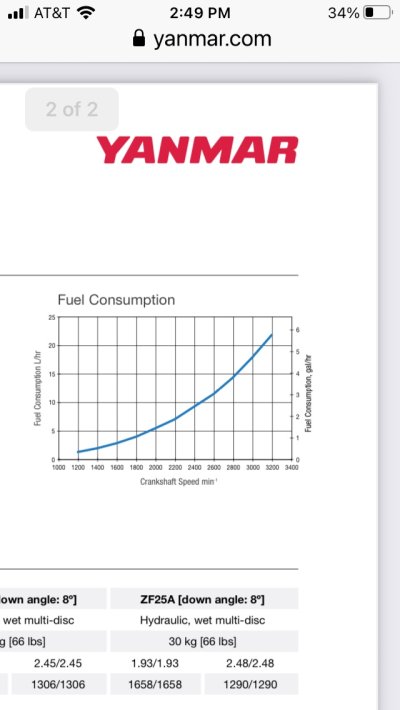Sailor of Fortune
Guru
Here is the range estimate from the builder of my Allweather. 112 gallon tank.
5 knots ~1 qt./hr. NMPG=~20 ~2000NM+
6 knots ~2 qts./hr. NMPG=~10 ~1000NM+
7 knots ~3-4 qts./hr. NMPG=~5 ~500NM+
Love those boats!!
Here is the range estimate from the builder of my Allweather. 112 gallon tank.
5 knots ~1 qt./hr. NMPG=~20 ~2000NM+
6 knots ~2 qts./hr. NMPG=~10 ~1000NM+
7 knots ~3-4 qts./hr. NMPG=~5 ~500NM+
As an ex-delivery skipper, if I'd listened to owners estimates on fuel burn, I'd still be floating out of fuel 75 miles offshore.
Very, very few owners use their boats in a manner to accurately estimate fuel consumption, and very, very few have adequate instruments to measure. Especially against sea state.
Estimates in threads like these are well meaning. But are no better than "one that got away" fish stories.
Peter
Peter, if the boat has the newer gen fuel monitoring systems, determining fuel burn and then comparing SOG against different sea states is fairly straight forward IMO.
My experience would reflect almost exactly what Richard quoted (based on 4 cruising seasons). However, I have not gone from Puget Sound to Ketchikan without refuelling. 950 nm range with 20% reserve.In five summers and about 17,000 nm of cruising mostly at 7-7.5 knots, we averaged about 3.7 nmpg, without trying to correct for some fuel being used by the genset. With 320 gallons of diesel tankage, our range with a 20% reserve would be about 950 nm. Well more than enough to go from Puget Sound to Ketchikan, which we have found convenient to do without fuel stops.
Wifey B: But he's right about owners. I know other delivery captains who run into that all the time. If it's not monitored and recorded at various speeds then useless in that business. I've seen owners say their boat could make it but Captain knew otherwise and took 6 drums along and used them all.
For range, I rely on an accurate fuel flow maretron instrument to measure usage, which feeds data to the Garmins for dynamic range calculations. I compare SOG to my speed through the water to keep an eye on the effects of current. 600 gallons of diesel...
Understood - and I've been on several boats newer boats now with full engine instrumentation. The ones I've been on (most recently, 2014 Cummins') fuel burn numbers still don't track on refill - the electronic totalizer calculation is always optimistic, and often by a lot. I suspect these controls are less accurate at low flow volumes. And there is thr difficulty of filling large, often awkwardly placed tanks with crossovers that sometimes vary by up to 10% of full capacity. Plus most owners do day hops with in/out in protected water, then extrapolate this to some sort of range with implication they could get to Hawaii. Not with me aboard.Peter, if the boat has the newer gen fuel monitoring systems, determining fuel burn and then comparing SOG against different sea states is fairly straight forward IMO.

In theory 2 x 3500 litres (1850 gal) should give 3700 NM range @ a bit over 8 knots at 1250 rpm burning under 4 gph.
We usually do a bit over 7 knots @ 1150 rpm on passage so range should increase marginally.
